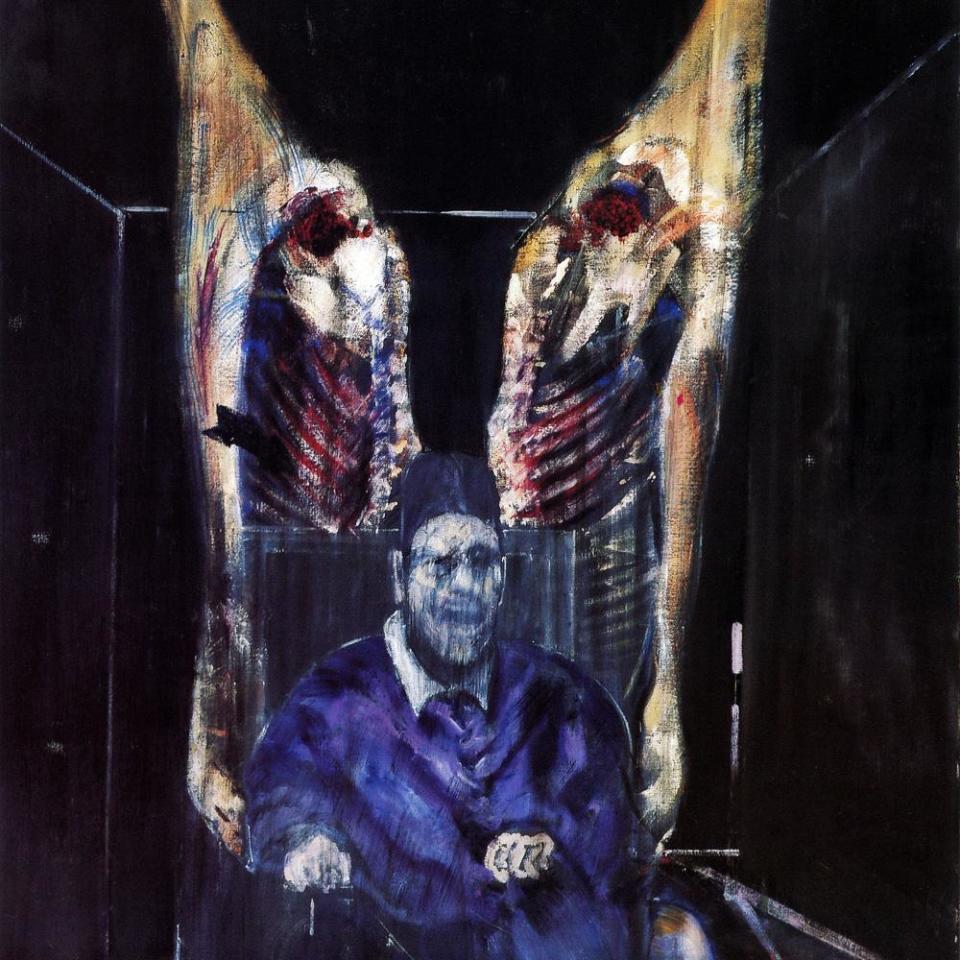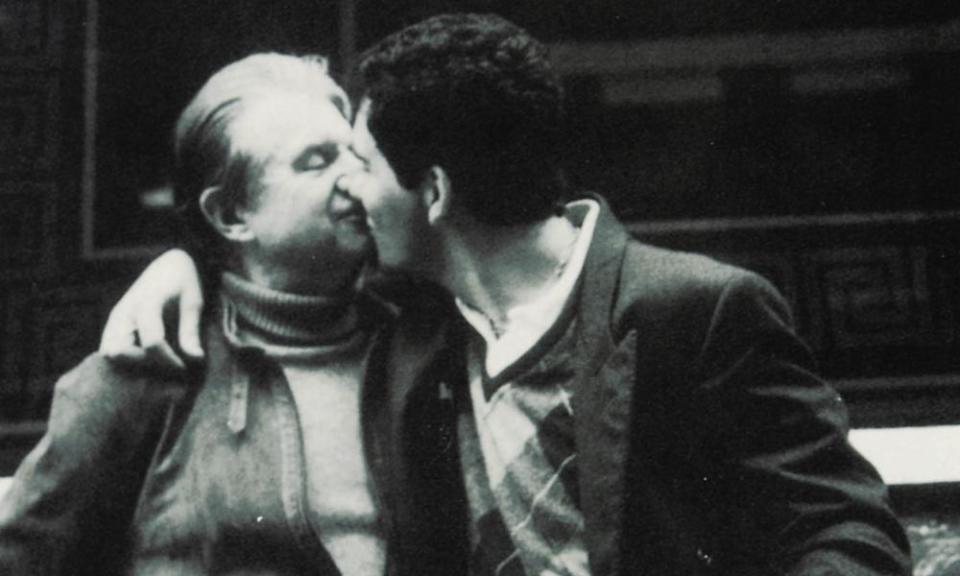Francis Bacon: Revelations review – a landmark biography
Francis Bacon didn’t just create some of the most unforgettable images of the human figure in 20th-century painting. He created “Francis Bacon”, a legendary persona: big beast of the London art world, wild man and bon vivant, whose raw painterly gift – he is one of only three British artists to be given two retrospectives at the Tate Gallery in their lifetime – was matched by his appetite for champagne, gambling and rough sex with East End crooks. His death in 1992 triggered a run of tell-all biographies, including first-hand accounts by his friends. What further revelations, you wonder, can there be?
Most of the surprises in this landmark new biography of Bacon, the first for 25 years, concern his early life and career, which turn out to have been – at least outwardly – embarrassingly conventional. Born in Dublin in 1909 to Anglo-Irish gentry, Bacon grew up in a series of big country houses, with dashes to England during the Irish revolutionary period. He was severely asthmatic. One of his childhood memories was being shut into a dark cupboard by a housemaid for long periods; he said that the feeling of asphyxiation resembled an asthma attack. He also remembered the entire family hiding in their locked rooms at night, in dread of a visit from the IRA. Suffocation, confinement, a sense of terror – the foundations of Francis Bacon, man and artist, were being laid.
He had a gift for free-form queening in an era when having gay sex was still a criminal offence. The teenaged Francis once turned up to a fancy-dress party as a flapper, wearing a beaded dress and an Eton crop; as an adult he was partial to pancake foundation and red lipstick. His fox-hunting father preferred his other two sons, both of whom died young (Bacon later claimed that his father ordered his grooms to whip him). At 17 he escaped to London, where he managed to get by on an allowance from his mother, which he supplemented through petty theft and by picking up wealthy older men. He read Nietzsche, though he liked to say that he’d never opened a book in his youth. In spite of protracted stays in Berlin and Paris he denied that he’d ever had any art classes, either: he would present himself as a fatherless child, a feral rent boy, an untutored genius with a paintbrush. Wherever he went his nanny went too, remaining his live-in companion until he was in his 40s.
Though he was 'stunned' by Picasso’s work in Paris, his initial response was to go and create more Wilton atrocities
But the embarrassing part is that Bacon was, in his early 20s, an interior designer. Mark Stevens and Annalyn Swan have dug deep and uncovered all sorts of excruciating details about Bacon’s time in Paris and afterwards. Unlike so many artists of the period – among them his later hero, Picasso – he didn’t haunt Montparnasse. “As the painters in Montparnasse remade modern art,” we’re told, “he began to design rugs and chairs.” Not just any old rugs and chairs: Royal Wilton rugs with trendy abstract motifs; seats like unfolded paper clips complementing tubular steel tables that had pink legs and glass tops, as a magazine review boasted, “half frosted and half clear”. And room screens painted with guitar-shaped silhouettes, cocktail shelves, art deco seagulls, calfskin pouffes. Though he was “stunned” by Picasso’s Cent Designs (100 Drawings) in Paris in 1927, his initial response was to go and create more Wilton atrocities.
But then, in the 1930s, just as Europe was entering the long shadow of fascism, Bacon – untrained would-be painter, rejected son – discovered the Crucifixion. There’s a sense, as Stevens and Swan suggest, that “almost all of Bacon’s subsequent art could be regarded as part of a broader Crucifixion-like scene in which the central event was rarely presented while all around and to every side – in innumerable smaller scenes, like Stations of the Cross – pictures emerged that were related to the central theme”. He wasn’t looking for the Christian cross, but for one stripped of religious belief, a wider symbol of a suffering self and a damaged world.

Bacon came across Picasso’s studies of the 16th-century German painter Matthias Grünewald’s graphic Isenheim Altarpiece in 1933. Their bold distortions showed him how to reconcile modernism with his own determination, at a time when art insisted on abstraction, to focus on the human figure. Bacon’s figures are, as he said of Picasso’s, “extraordinary formal inventions”, not quite like anything that had come before. He destroyed almost all his youthful work, but a black-and-white 1933 Bacon Crucifixion survives, with a tiny head topping a ghostly splayed figure, like nailed-down ectoplasm. His breakthrough painting, produced in his mid-30s, was Three Studies for Figures at the Base of a Crucifixion (1944), a triptych of grotesque crying creatures, surrounded by scraps of Edwardian furniture, eerily aglow in a burnt orange light. They are clearly influenced by Picasso’s biomorphs, but with a quality of darkness and a feverish melancholy all of their own.
Bacon was peculiarly modern in his fascination with X-rays, photographs, film, and other technological ways of testing the human surface. Sometimes, however, he looked forwards by looking backwards. Though he lacked formal training, his vision was shaped by the example of certain old masters: what Stevens and Swan call Rembrandt’s “meaty and mysterious” brush, Velázquez’s pomp and splendour. He showed his appreciation of these models by butchering them. His filleting of Velázquez’s Portrait of Innocent X, and contemporary photographs of the bespectacled Pius XII, gave 20th-century art some of its most iconic images. He would paint these Holy Fathers over and over, their mouths levered open in a scream borrowed from a still in Sergei Eisenstein’s 1925 movie Battleship Potemkin; robed in purple and cut into ribbons, surrounded by carcasses, enclosed by the geometry of vanishing rooms.
He was terrible at meeting deadlines because he was so often drunk, broke, or in a state of sexual crisis
There is rage and despair in this work, but there’s humour, too. Stephen Spender said that Bacon’s painting often has “the quality of an immensely tragic joke”. It’s theatrical and unapologetically exhibitionist. Bacon takes pleasure in exposing the truths we usually like to ignore: the perishability of the gorgeously dressed body, the emptiness of secular and religious authority, all the bogus certainties of civilised life. His popes, tarted up, tortured and surrounded by heavy gold frames, are, Stevens and Swann note with a twinkle, “the old masters in drag”.
The triptych form was both Bacon’s homage to an older tradition and his response to the cubist challenge of depicting different spatial and temporal perspectives simultaneously. He made it his own, just as the entrapping walls and boxes in his pictures, and the curved space that implies a stage or sacrificial arena, are enduringly part of his dramatic idiom. Size was important to Bacon simply because a larger canvas has a bigger impact on the nervous system. Yet his vast three-acters proved, for the best part of his career, to be unsellable. His paintings didn’t fit into the typical dimensions of the English house, but he went on working on a grand scale all the same.

Bacon’s emotional and erotic life didn’t fit into a conventional domestic space either. Having grown up in the stately homes of Ireland he flitted, in middle age, from room to makeshift room. His last studio-cum-bedsit, around the corner from Harrods, was famous for its squalor. He liked to gamble in Monte Carlo, to have sadomasochistic sex in Soho, and to order magnums of Bollinger in any place. He was terrible at meeting deadlines because he was so often drunk, broke, or in a state of sexual crisis. Two of his long-term lovers died of substance abuse, each on the eve of one of his major exhibitions.
The world finally caught up with Bacon’s airless psychic landscape, his flayed bodies and mutilated fathers. In the decades following the second world war, his personal drama and Nietzschean bleakness came to reflect the nihilism afflicting western civilisation. Once Bacon became fashionable (and expensive) it became fashionable, in turn, to dismiss his work as Grand Guignol, but he always insisted that he was simply portraying the reality of the conditions that had shaped him: “the revolutionary Irish movement, Sinn Féin, and the wars, Hiroshima, Hitler, the death camps, and daily violence that I’ve experienced all my life”. The power of this meticulously researched and utterly compelling biography lies not just in the confidence with which it demonstrates the truth of that statement, but in its quieter revelations. Bacon’s asthma eventually led to his death by heart attack at the age of 82. Yet this lifelong asthmatic, we learn, had sometimes mixed dust into his paint. It’s as if he was making certain, all along, that beneath the “Francis Bacon” persona he and his art would remain of a piece.
• Elizabeth’s Lowry’s novel Dark Water was longlisted for the Walter Scott prize in 2019. Her novel about Thomas Hardy, The Chosen, will be published in 2022. Francis Bacon: Revelations is published by William Collins (£30). To order a copy go to guardianbookshop.com. Delivery charges may apply.


